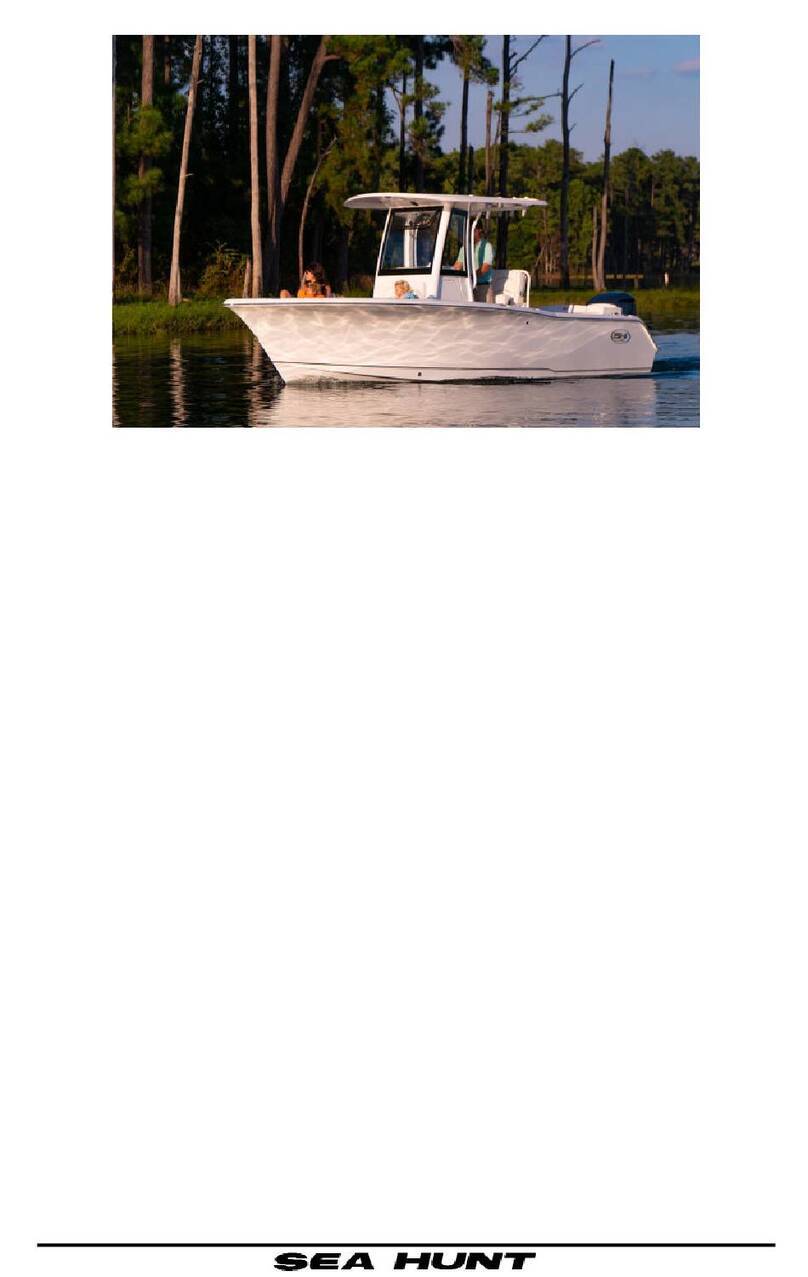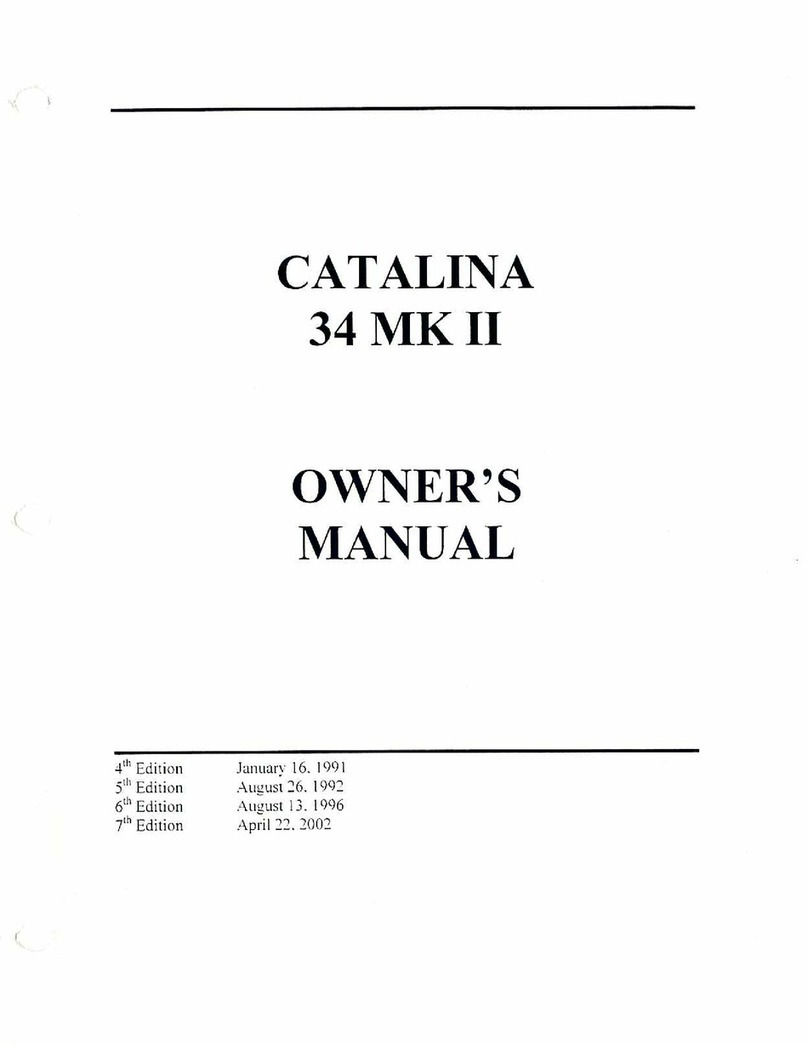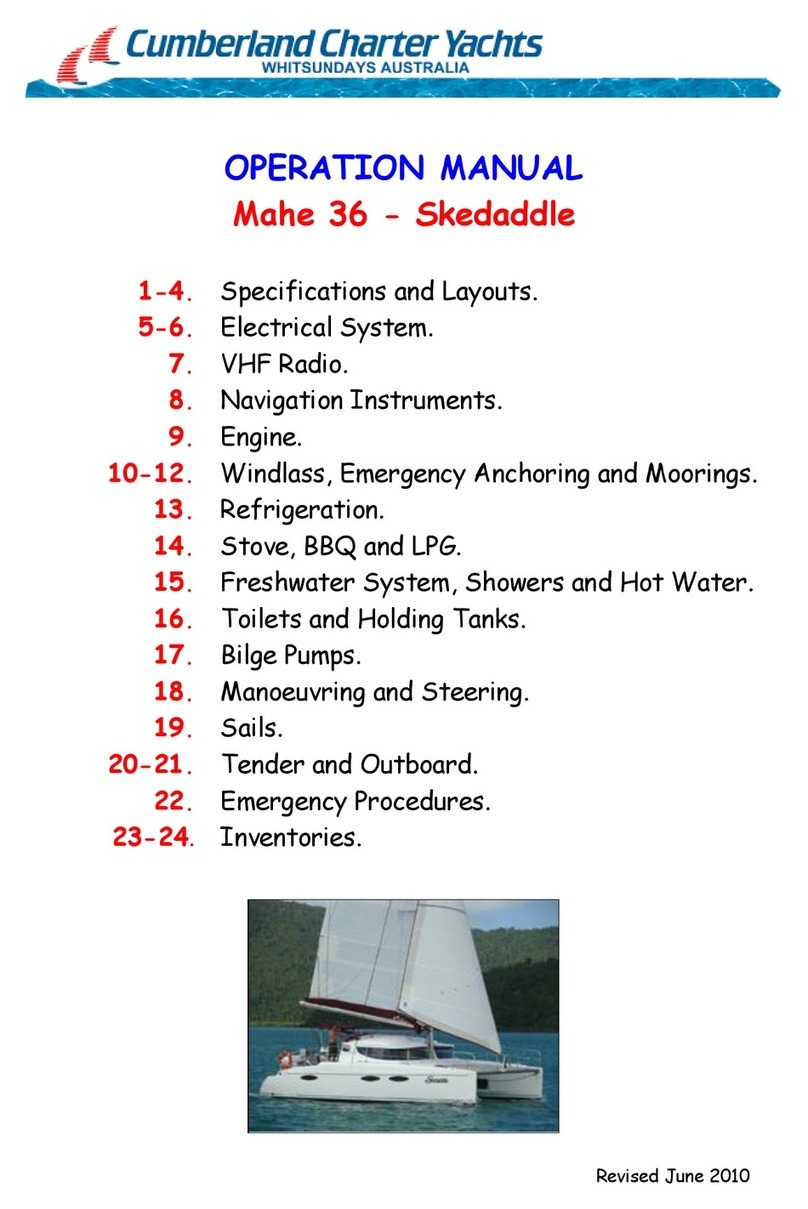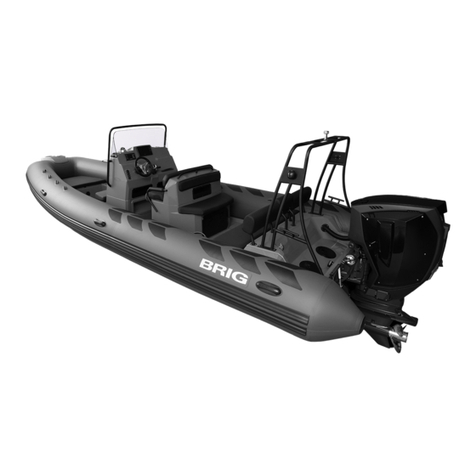Sea Hunt 2012 Gamefish series User manual

64
1
Dear Sea Hunt Owner:
Welcome to the Sea Hunt owner’s family! Buying and owning a
boat is a very special experience. Of all the many products
you’ll ever own we want your Sea Hunt experience to be the
absolute best. That means providing the descriptions, explana-
tions and technical support that you need to enjoy your Sea
Hunt with confidence and security.
The seaworthiness and safety of your Sea Hunt is highly de-
pendent on the operation, maintenance and care of your boat,
so please read this manual thoroughly and keep it around for
reference. If you need further explanation or “hands-on” help,
don’t hesitate to ask the people at your Sea Hunt dealership;
they have experience with the systems and operations of your
boat. If for any reason you need additional help, please feel
free to call us at the factory. We sincerely want to provide you
with the help and information that will make your Sea Hunt ex-
perience delightful.
Thanks for choosing a Sea Hunt. All of us at the factory and at
your dealership are dedicated to earning your confidence in Sea
Hunt Boats. Again, welcome to the family.
Sincerely yours,
Bubba Roof
President
SEA HUNT BOATS, INC.
Sea Hunt Boats
2348 Shop Road
Columbia, SC 29201
Phone: (803) 755-6539
Fax: (803) 755-3399
www.seahuntboats.com

2
TABLE
OF
C
ONTENTS
OWNERS
ORIENTATION
Orientation . . . . . . . . . . . . . . . . . . . . . . . . . .
Warranty
Information
. . . . . . . . . . . . . . . . . .
NMMA Certified
Areas for
Dealer Assistance
. . . . . . . . . . . . .
Hazard
Warning
Symbols . . . . . . . . . . . . .
Dealer
Pre-delivery/Delivery
Responsibilities
Consumer
Responsibilities . . . . . . . . . . . . . .
Boat
.
Model
Identification . . . . . . . . . . . . . . .
BOATING
SAFETY
Required
.
Safety
Equipment . . . . . . . . . . . . . .
Fire
Extinguisher . . . . . . . . . . . . . . . . . . . . . .
Personal
Flotation Device (PFD) . . . . . . . . . .
Sound
.
Signaling
Devices . . . . . . . . . . . . . . .
Visual
Distress
Signals . . . . . . . . . . . . . . .
Lighting . . . . . . . . . . . . . . . . . . . . . . . . . . . . .
Additional
Recommended
Equipment . . . . . .
Registration
Numbers . . . . . . . . . . . . . . . . . .
Emergency
Information . . . . . . . . . . . . . . . . .
Emergency
Stop
Switch . . . . . . . . . . . . . . . . .
Rendering
.
Assistance . . . . . . . . . . . . . . . . .
Accident
Reporting . . . . . . . . . . . . . . . . . . . .
Boating
Safety
Tips . . . . . . . . . . . . . . . . . . . .
Basic Rules of the Road . . . . . . . . . . . . . . . .
Loading
Capacity . . . . . . . . . . . . . . . . . . . . . .
Carbon
Monoxide . . . . . . . . . . . . . . . . . . . . .
Suggested
Boating
Classes
and
Literature
. .
GENERAL
BOATING
INFORMATION
Fuel System Information . . . . . . . . . . . . . . .
Fueling . . . . . . . . . . . . . . . . . . . . . . . . . . . . .
Discharge
Regulations . . . . . . . . . . . . . . . . .
Discharge
of
Oil . . . . . . . . . . . . . . . . . . . . . . .
Disposal
of
Plastics
and
Other
Waste . . . . . . .
Driving . . . . . . . . . . . . . . . . . . . . . . . . . . . . . .
Trailering . . . . . . . . . . . . . . . . . . . . . . . .
Pre-start
Checklist . . . . . . . . . . . . . . . . . . . .
.
Leaving/Approaching
the
Dock . . . . . . .
Towing
or
Being
Towed . . . . . . . . . . . . .
Shallow
Water . . . . . . . . . . . . . . . . . . .
Anchoring . . . . . . . . . . . . . . . . . . . . . . .
Using
a
Windlass . . . . . . . . . . . . . . . . .
General
Information
on
Boat
Handling .
Common
Nautical
Terms . . . . . . . . . . .
PERFORMANCE
Performance
Factors . . . . . . . . . . . . . .
Engine
Efficiency . . . . . . . . . . . . . . . . .
Weather
Conditions . . . . . . . . . . . . . . .
Load
Distribution . . . . . . . . . . . . . . . . . .
Marine
Growth . . . . . . . . . . . . . . . . . . . .
Trim . . . . . . . . . . . . . . . . . . . . . . . . . . . .
Propeller . . . . . . . . . . . . . . . . . . . . . . . .
Propeller Terms . . . . . . . . . . . . . . . . . . .
Outboard Propulsion System . . . . . . . . .
Engine
Systems . . . . . . . . . . . . . . . . . . .
Engine
Warranty . . . . . . . . . . . . . . .
Throttle/Shift
Control . . . . . . . . . . . . . . .
Neutral
Safety . . . . . . . . . . . . . . . . . . . .
Shift
Function . . . . . . . . . . . . . . . . . . . . .
Throttle
Function. . . . . . . . . . . . . . . . . . .
Forward
Throttle . . . . . . . . . . . . . . . . . . .
Reverse
Throttle . . . . . . . . . . . . . . . . . . .
Neutral
Throttle . . . . . . . . . . . . . . . . .
Stopping/Braking . . . . . . . . . . . . . . . . . .
Control
Cables . . . . . . . . . . . . . . . . . . . .
Steering . . . . . . . . . . . . . . . . . . . . . . . . .
Hydraulic
Steering . . . . . . . . . . . . . . . . .
Trim Tabs . . . . . . . . . . . . . . . . . . . . . . .
GAUGES
AND
SWITCHES
Yamaha Analog
.
Gauges . . . . . . . . . . .
Tachometer . . . . . . . . . . . . . . . . . . . . .
Speedometer . . . . . . . . . . . . . . . . . . . .
Fuel
Gauge . . . . . . . . . . . . . . . . . . . .
Usable Fuel . . . . . . . . . . . . . . . . . . . . .
4
4
4
4
5
6
6
7
8
8
8
8
8
8
8
9
10
12
12
12
12
14
16
16
17
18
19
20
20
20
21
21
23
24
24
25
25
26
26
27
28
28
28
28
28
28
29
29
29
30
30
30
30
30
30
30
31
31
31
31
31
32
32
33
33
33
33
33
63
Sea Hunt Boat Manufacturing Company, Inc. LIMITED WARRANTY
One-Year Limited Warranty
(a) SEA HUNT BOAT MFG. CO., INC. (SEA HUNT) warrants to the original purchaser
for a period of one year from the date of delivery to the original purchaser that each SEA
HUNT boat will be free from defects in material and workmanship under normal recom-
mended use.
(b) During this one year period, warranty repairs will be made without charge by SEA
HUNT at it's plant in Columbia, SC or, at SEA HUNT's option, by an Authorized SEA HUNT
Marine Dealer. Transportation charges to and from the place of repair will be the responsi-
bility of the original purchaser. All repairs made under this warranty are subject to the ap-
proval of an Authorized SEA HUNT Representative.
(c) This One-Year Limited Warranty does not apply to carpet, upholstery, gelcoat fin-
ishes, osmosis, blisters, cracks, or crazing, or to equipment and accessories not manufac-
tured by SEA HUNT, including windshield, windshield breakage, engine or drive train, or
parts which have been altered or subjected to misuse or negligence, or to the achievement
of any particular level of performance.
(d) This One-Year Limited Warranty extends only to the original purchaser and may
not be transferred to subsequent purchasers.
Ten-Year Hull Limited Warranty
(a) SEA HUNT warrants to the original purchaser for a period of ten years from the
date of delivery to the original purchaser that each SEA HUNT boat will be free from de-
fects in material and workmanship under normal recommended use.
(b) SEA HUNT will repair or replace, at its option, any SEA HUNT hull found to have a
structural defect, provided the original purchaser returns the boat to SEA HUNT at its plant
in Columbia, SC, or, at SEA HUNT's option, by an Authorized SEA HUNT Marine Dealer.
Transportation charges to and from the place of repair will be the responsibility of the origi-
nal purchaser.
(c) This Ten-Year Hull Limited Warranty does not apply to non-structural hull surface
changes, such as fading, checking, crazing, blisters, and gelcoat cracks. Further, this war-
ranty also does not apply to hull damage caused by items not installed on the boat by SEA
HUNT, accidents, neglect, unauthorized repairs, or by the boat's trailer. This warranty also
does not apply to boats used for or in racing or for governmental, commercial or business
use.
Limitation of Liability and Disclaimer
THIS WARRANTY IS IN LIEU OF ALL OTHER WARRANTIES, EXPRESS OR IM-
PLIED, INCLUDING THE IMPLIED WARRANTIES OR MERCHANTABILITY AND FITNESS
FOR A PARTICULAR PURPOSE. IMPLIED WARRANTIES, IF ANY, WHICH CANNOT BE
DISCLAIMED, ARE LIMITED IN DURATION TO THE DURATION STATED ABOVE. ALL
OTHER OBLIGATIONS OR LIABILITIES, INCLUDING LIABILITY FOR LOSS, OR CONSE-
QUENTIAL DAMAGES ARE HEREBY EXCLUDED. SOME STATES DO NOT ALLOW LIMI-
TATIONS ON HOW LONG AN IMPLIED WARRANTY LASTS OR THE EXCLUSION OR
LIMITATION OF INCIDENTAL OR CONSEQUENTIAL DAMAGES, SO THE ABOVE LIMI-
TAIONS OR EXCLUSIONS MAY NOT APPLY TO YOU. THIS WARRANTY GIVES YOU
SPECIFIC LEGAL RIGHTS, AND YOU MAY ALSO HAVE OTHER RIGHTS WHICH VARY
FROM STATE TO STATE.
SEA HUNT reserves the right to alter models, change colors, specifications, materials,
equipment, component parts and prices, or cease production of certain models at any time
without notice. Such changes shall be made without incurring obligations to equip or modify
units produced prior to the date of such changes.
LIMITED WARRANTY

62
3
Trim
Gauge . . . . . . . . . . . . . . . . . . . . .
Voltmeter . . . . . . . . . . . . . . . . . . . . . . .
Engine
Lubrication . . . . . . . . . . . . . . . .
4-Stroke
Engines . . . . . . . . . . . . . . . . .
Warning
Systems . . . . . . . . . . . . . . . . .
Water Temperature and Oil Level . . . .
Yamaha
Digital
Instrumentation . . . . . .
Multi-Function Tachometer . . . . . . . . .
Multi-Function Speedometer . . . . . . . .
Clock . . . . . . . . . . . . . . . . . . . . . . . . . .
Fuel
.
Gauge . . . . . . . . . . . . . . . . . . . . .
Low
.
Fuel
.
Warning
.
Indicator . . . . . . . . .
Overheat
.
Warning
.
Indicator . . . . . . . . .
Trip Meter . . . . . . . . . . . . . . . . . . . . . .
Oil Level Warning Light . . . . . . . . . . . .
Revolutions per Minute (RPM) . . . . . . .
Trim . . . . . . . . . . . . . . . . . . . . . . . . . . .
Switch
Panel . . . . . . . . . . . . . . . . . . . .
Bilge
Pump . . . . . . . . . . . . . . . . . . . . . .
Cockpit
Lights . . . . . . . . . . . . . . . . . . .
Horn . . . . . . . . . . . . . . . . . . . . . . . . . . .
Livewell . . . . . . . . . . . . . . . . . . . .
Washdown . . . . . . . . . . . . . . . . . . . . .
Navigation/Anchor
Lights . . . . . . . . . .
Accessory . . . . . . . . . . . . . . . . . . . . . .
Circuit Breakers . . . . . . . . . . . . . . . . .
MAINTENANCE
&
SERVICE
General . . . . . . . . . . . . . . . . . . . . . . . .
Exterior
Fiberglass
Finish . . . . . . . . .
Maintenance . . . . . . . . . . . . . . . . . . . .
Cleaning . . . . . . . . . . . . . . . . . . . . . . .
Waxing . . . . . . . . . . . . . . . . . . . . . . . .
Repairing . . . . . . . . . . . . . . . . . . . . . .
Bottom
Paint . . . . . . . . . . . . . . . . . . . .
Canvas . . . . . . . . . . . . . . . . . . . . . . . .
Maintenance . . . . . . . . . . . . . . . . . . . .
Zippers
&
Snaps . . . . . . . . . . . . . . .
Vinyl . . . . . . . . . . . . . . . . . . . . . . . . . .
Storage . . . . . . . . . . . . . . . . . . . . . . . .
Upholstery . . . . . . . . . . . . . . . . . . . . . .
Hardware
Mounting . . . . . . . . . . . . . . .
Caulking/Gasket . . . . . . . . . . . . . . . . .
TABLE
OF
C
ONTENTS
33
34
34
34
34
34
34
34
34
35
35
35
35
35
35
35
35
36
36
36
36
36
36
36
36
36
37
37
37
37
37
38
39
39
39
41
41
42
42
42
42
Stainless
Steel
Rails
&
Hardware . . . . . . . . .
Anodized
Aluminum
Components . . . . . . . .
Leaning
Posts,
Rod
Holders,
T-Top Frames. .
Scuppers . . . . . . . . . . . . . . . . . . . . . . . . . . .
Fuel
System
Maintenance . . . . . . . . . . . . . .
Fuel
Tank
Compartment . . . . . . . . . . . . . . .
Batteries . . . . . . . . . . . . . . . . . . . . . . . . . . .
WINTERIZATION
AND
STORAGE
General
Information . . . . . . . . . . . . . . . . . .
Boat
Storage . . . . . . . . . . . . . . . . . . . . . . . .
Winterization
.
and
Storage . . . . . . . . . . . . . .
Cleaning
and
Lubricating
.
the
.
Boat . . . . . . .
Draining
and
Water
.
Systems . . . . . . . . . . .
Fuel
System . . . . . . . . . . . . . . . . . . . . . . . .
Batteries . . . . . . . . . . . . . . . . . . . . . . . . . . .
Engines . . . . . . . . . . . . . . . . . . . . . . . . . . . .
Storage
Checklist . . . . . . . . . . . . . . . . . . . .
Commissioning
Boat
After
Storage . . . . . . .
Prior
to
Launching . . . . . . . . . . . . . . . . . . . .
After
Launching . . . . . . . . . . . . . . . . . . . . . .
Gamefish series supplement . . . . . . . . . . . .
Head systems . . . . . . . . . . . . . . . . . . . . . . .
WIRING
DIAGRAMS
6 Circuit Instrument Panel . . . . . . . . . . . . ..
6 Circuit Wiring Harness . . . . . . . . . . . . . . .
8 Circuit Instrument Panel . . . . . . . . . . . . . .
8 Circuit Wiring Harness . . . . . . . . . . . . . . .
Escape Instrument Panel . . . . . . . . . . . . . ..
EscapeWiringHarness .... ..
. .. . . . . . .. . .
Gamefish Switch Panel . . . . . . . . . . . . . . . .
Gamefish Wiring Harness. . . . . . . . . . . . . . .
Trolling Motor Wiring . . . . . . . . . . . . . .
LIMITED
WARRANTY
. . . . . . . . . . . . . . . ..
SERVICE / MAINTENANCE LOG
. . . 64, Inside
back cover
42
43
43
43
43
44
44
46
46
47
47
47
48
48
48
49
49
50
50
51
54
57
57
58
58
59
59
60
61
62
63

4
OWNERS ORIENTATION
ORIENTATION
Your Sea Hunt has many features and accessories that have exist-
ing printed material provided by the various equipment manufacturers.
This information is compiled in a package that we will reference
throughout this manual. Consult your Sea Hunt Owner’s Manual and
Engine Manual to advise on proper operation, maintenance intervals,
specifications, warranty, and other useful information.
While reading your Sea Hunt Owner’s Manual, you will find other
technical literature referenced as resources for detailed information.
When you take delivery of your new Sea Hunt it will also consist of
several other items that you will need to become familiar with, such as
operation guides, informative labels, and product warranties. Your
Owner’s Manual can also be used to record other boat specifics such
as maintenance records and additional equipment and accessories
installed after delivery.
WARRANTY INFORMATION
The Sea Hunt warranty is located on the last page of this manual.
Upon the purchase of your new Sea Hunt boat, the dealer will fill out a
warranty card. This card will be kept on file at the dealership and at
the Sea Hunt factory. A copy will be provided for your records and
should be kept with other valuable documents for future reference. For
questions regarding your warranty please contact your dealership.
NMMACERTIFIED
InadditiontocomplyingwithallapplicableUnitedStatesCoastGuard
(USCG)safetyrequirements,SeaHuntBoatsarecertifiedbytheNationalMarine
ManufacturersAssociation(NMMA). TheNMMAspecifiesthestandardspub-
lishedbytheAmericanBoatandYachtCouncil(ABYC)tobefollowedinthede-
signandmanufactureofrecreationalvessels. Seehttp://www.nmma.org/
certification/programs/boats/ formoredetails.
AREAS FOR DEALER ASSISTANCE
Your new Sea Hunt is built with pride and the utmost care is taken
to make your ownership experience memorable. Every Sea Hunt goes
through a rigorous quality control inspection throughout the entire
manufacturing process. Subsequent to the final factory overview your
dealer must perform additional pre-delivery checks and approve your
Sea Hunt for delivery.
61
GAMEFISH WIRING
HARNESS

60
GAMEFISH SWITCH
PANEL
5
HAZARD WARNING SYMBOLS
The hazard warning symbols shown below are applied throughout
this manual to alert the customer of potentially dangerous situations
that can lead to product damage, personal injury and/or death. We
urge you to observe these warnings and comply with all safety recom-
mendations.

6
DEALER PRE-DELIVERY / DELIVERY RESPONSIBILITIES
Provide orientation of the general operation of your Sea Hunt pack-
age.
A manufacturers warranty registration must be completed and
signed by both the dealer and consumer to validate and activate
applicable warranties.
A review of all warranties, pointing out the importance of mailing
warranty and registration to various manufacturers within the re-
quired time limits.
An explanation of safety issues regarding the use of all systems
and components.
Guidance on acquiring local and out of area service during and out
of warranty periods.
Review local and national regulations.
CONSUMER RESPONSIBILITIES
The following are responsibilities of the Sea Hunt owner:
Read and understand the express limited warranty.
Study all literature and instructions.
Be familiar with local and national regulations.
Examine the boat and confirm all systems are working properly at
the time of accepting delivery.
Following 10-20 hours of operation, contact your selling dealer to
schedule a 20 hour inspection service.
Perform proper maintenance and periodic servicing of the boat in
accordance with manufacturers recommendation in the Owner’s
Manuals.
59
ESCAPE SERIES PANEL
ESCAPE SERIES
WIRING HARNESS

58
8 CIRCUIT PANEL
8 CIRCUIT
WIRING HARNESS
7
BOAT MODEL IDENTIFICATION
Sea Hunt Boats has a permanent record of your boat, which is
identified through the “Hull Identification Number” (HIN). Data regard-
ing equipment and accessories, as well as dealer/shipping information
is documented when your new Sea Hunt is “Warranty Registered”.
The “Hull Identification Number” is located on the starboard side of
the transom. It is a significant source of identification and must be
noted in all correspondence and orders.
When contacting your dealer concerning maintenance or warran-
ties, please have all relevant information such as serial numbers (HIN)
and model number available. This information is on your copy of the
warranty card.
REGISTRATION NUMBERS
Federal and State laws require a power boat to be registered in the
state where it is primarily used. Registration numbers and validation
stickers must be displayed according to regulations. The registration cer-
tificate must be on board when boating. The boat serial number, or Hull
Identification Number (HIN), is required on the registration form. The
HIN should be included on all documents or any correspondence to pro-
vide you timely service.

8
BOATING SAFETY
REQUIRED SAFETY EQUIPMENT
The US Coast Guard (USCG) requires that
every boat have specific equipment on board.
Check with local regulations on mandatory
equipment apart from the list of Coast Guard re-
quirements.
FIRE EXTINGUISHER
At least one Type-1 hand held portable fire ex-
tinguisher must be carried on board. For boats
over 20’ two are required. Check extinguisher
regularly for charge status.
PERSONAL FLOTATION DEVICE (PFD)
You must have a USCG approved personal
flotation device of Type I, II, or III aboard for
each passenger, in addition to one Type IV
throwable PFD. Always wear a PFD when
boating. In some states, children are required
to wear a PFD at all times. Check your local
regulations.
SOUND SIGNALING DEVICES
Your Sea Hunt is equipped with an electric
horn which meets the USCG requirements for
a sound signal device.
VISUAL DISTRESS SIGNALS
USCG approved visual distress signals are
required for day and night use when operating
on US waters. Approved signals include flares,
orange smoke, an orange distress flag, or an
electric distress light.
LIGHTING
Your Sea Hunt boat is equipped with naviga-
tion lights which comply with both Inland and
International rules.
57
6 CIRCUIT PANEL
6 CIRCUIT
WIRING HARNESS

56
ELECTRICAL DIAGRAMS
Information in the following section is given for reference and assis-
tance in troubleshooting. Since Sea Hunt Boats strives to constantly
improve all areas of construction, some revisions or equipment may
exist that are not noted on the diagram. Consult the factory if you have
questions about specific circuits that are not shown.
All wiring conforms to ABYC standards for size, temperature rating
and color codes. Always use marine rated components when perform-
ing any work on your Sea Hunt’s electrical system, and ensure all cir-
cuits have appropriate overcurrent protection. Sea Hunt Boats always
recommends using a qualified marine electrician for any repairs or
additions to your boat’s system.
9
ADDITIONAL RECOMMENDED EQUIPMENT
In addition to the required safety equipment, there are additional
items that will provide an extra margin of safety and convenience for
you and your passengers while boating.
- First aid kit and manual
- Anchor with at least 100’ of rode
- Mooring lines and fenders
- Combination oar/boat hook
- Mooring lines and fenders
- Non-aerosol lubricant
-Tool kit
- Spare engine fuses
(see engine operator’s manual)
- Local charts and compass
-Waterproof flashlight
- Portable AM/FM radio with weather
band
- Spare flashlight and radio batteries
- Sunglasses and sun block
Normally, this equipment is dependent on the body of water and
the length of the trip. Your dealer can assist you in selecting the appro-
priate equipment for your trip.
Keep tools and spare parts in good condition. Replace parts re-
moved from spare parts kit. Most importantly use U.S. Coast Guard
approved or marine certified parts where applicable. Conditions found
requiring corrective action should be serviced by a qualified repair-
man.

10
Try to turn the engine OFF to prevent damage.
Have everyone aboard put on their personal flotation device.
If others were on board, try to locate them, and guide them to the
safety of the hull.
STAY WITH THE BOAT! All Sea Hunt Boats under 20 feet in
length are designed to meet or exceed level flotation require-
ments. so that, if swamped, the crew may be able to bail the cock-
pit out and restart the engine. Larger models should keep a portion
of the boat above water, depending on load and degree of any
damage to the hull.
Climb up on the hull and try to signal for assistance.
Don’t try to swim to shore. It’s usually farther than it looks.
Guard against swamping and capsizing; see that loaded items do
not shift in the boat and do not use too much power or speed in
turns.
EMERGENCY INFORMATION
While boating, unpleasant situations may develop. Before emergency
situations materialize you should prepare yourself on how to cope with
them, whether they happen aboard your vessel or someone else’s.
Prepare a game plan for specific situations that may occur such as fire,
man overboard or collision, to give you the confidence and ability nec-
essary for an emergency. The key factor is to remain calm, and ad-
vance planning will greatly improve your chances of doing this.
FIRES
A fire aboard your boat is very serious. In case of fire, you should im-
mediately stop your boat and shut off the engine. Have everyone
aboard put on their personal flotation device. If the fire is accessible,
use the fire extinguisher at the base of the flames using a sweeping
motion.
If the fire cannot be extinguished within a few minutes, use a distress
signal and call for help on the radio. All persons should jump over-
board and swim clear of the burning boat.
SWAMPING, FLOODING, OR
CAPSIZING
A boat may capsize or swamp
when least expected. Like fires,
try to formulate a plan in advance
on what to do if it should happen.
55
Gamefish 29 toilet pump and valve layout
With either system, the head manufacturer’s instructions are included
in your owner’s package– be sure to read and understand the recom-
mended operation and maintenance procedures in the manual and
abide by all laws and regulations for waste disposal. Remember–
discharge valves must be closed, and the key removed from the
switch or access to the toilet restricted when in a no-discharge
zone.
The Jabsco® electric toilet used in the Escape 250 and Edge 24 is
deck pumpout only; again, refer to the separate manual for specific
flush/fill and pumpout instructions As there is no overboard discharge
connection, access restrictions do not apply on these models.
Gamefish 25/27 toilet pump and valve layout

54
HEAD SYSTEMS
In 1972 (amended 1987) Congress enacted the Clean Water Act.
This law addresses a wide spectrum of water pollution problems, in-
cluding marine sewage from boats in navigable U.S. waters. The law
provides for “no discharge” by boats operated within three miles of
shore, in enclosed lakes and reservoirs or in rivers not capable of in-
terstate navigation. States may apply to the EPA to have other waters
declared “no discharge” if discharge of sewage would be harmful.
Therefore boats with toilets must be equipped with operable, Coast
Guard approved Marine Sanitation Device (MSD). These are designed
to either hold sewage for pump out ashore or discharge beyond the
three mile limit or treat the sewage to Federal standards prior to dis-
charge. Check with your local authorities or Coast Guard for any rules
which apply to the area where you do your boating.
In order to comply with the Clean Water Act, in addition to the dis-
charge seacock being kept closed, the key must be removed from the
pumpout switch (Gamefish 29) or the door to the head should be kept
locked (Gamefish 25 and 27) when operating the boat in a no-
discharge zone. Failure to follow these rules may lead to a citation if
boarded by the Coast Guard or other law enforcement agency.
All systems use fresh water only for flush and fill. The Fresh Wa-
ter pump switch on the helm panel must be on in order to use the
head system, and adequate water level must be maintained in the
freshwater tank.
The Gamefish 29 is equipped with a Dometic Sealand Vacuflush head
system. Be sure to read the literature that came with the head system
before using it. It uses a powerful vacuum to remove waste from the
toilet and deposit it in a holding tank. There is a deck plate installed on
the starboard gunwale beside the cockpit marked “Waste”- most mari-
nas and some municipalities can empty your holding tank through this
fitting. In areas where discharge is allowed, waste can be pumped
overboard. A key switch in the console operates this pump. Be sure
that the seacock is in the open position before operating the pump.
Damage to the pump could result if the seacock is closed. The vac-
uum created by pumping out the tank tends to slow the process. To
speed things up a bit, turn off the rocker switch that controls the vac-
uum generator and open the ball valve by depressing the flush lever
occasionally while operating the pumpout.
The Gamefish 25 and 27 models are equipped with a compact gravity
flush toilet with an integral holding tank. This system uses fresh water
also, so the freshwater pump must be on to flush the system. Waste is
removed either through the deck pumpout fitting or by overboard dis-
charge (where permitted).
11
COLLISIONS
If you are involved in a collision with another boat or a stationary ob-
ject (reef, sandbar, bridge, pier, etc.), first check everyone aboard for
injuries and then inspect your boat for damage.
Attempt to plug any holes you find.
If the boat is taking on water, have everyone put on their PFDs.
Signal for help.
WEATHER
STORMS
Getting caught in severe weather is hazardous. The best advice for
boaters in bad weather is to STAY HOME. Check with local weather
stations, the U.S. Coast Guard, or National Weather Service broad-
casts for the latest conditions. (162.4-162.55 MHz) It is recommended
to check the weather not only before but periodically while you are
boating, as weather conditions can change rapidly. If a storm ap-
proaches,
return to port or seek safe harbor immediately.
make sure all persons aboard are wearing a PFD.
reduce your speed and head into the wind as much as possible.
When a lightning storm ad-
vances certain safety precau-
tions should be taken. Dock the
boat and seek shelter on land.
If this is not possible seek ref-
uge inside the boat until the
storm has passed. Stay out of
the water! Lightning will seek a ground when it strikes and may pass
through metal components if it hits your boat. Avoid contact with metal
parts of the boat under these conditions.
FOG
If you encounter fog, set a course using your GPS or compass and
navigational chart. Reduce your speed. Have everyone aboard act as
lookouts to prevent collisions. Sound your horn intermittently to warn
others of your presence. You must also listen for signals from other
boaters in the area.

12
EMERGENCY STOP SWITCH
Sea Hunt boats are equipped with
an emergency stop switch that is sup-
plied by the engine manufacturer. This is
a safety feature that, if used properly,
will shut the engine(s) down if the opera-
tor leaves or falls from the helm position.
This ignition shutdown switch in-
cludes a shut-off switch, switch clip, lan-
yard and lanyard clip. The lanyard clip is
attached to the operator. If a situation
arises where the boat should stop, a pull
on the cord to release the clip from the
shut-off switch will shut down the en-
gines. To reset the emergency stop
switch, simply reinstall the switch clip.
The ultimate decision to use the emer-
gency stop switch rests with the captain/pilot.
RENDERING ASSISTANCE
The owner or operator of a vessel is required by law to render all
practical or necessary assistance to any person or vessel affected by
collision, accident or casualty. However, you should not endanger
your vessel or passengers to render assistance.
ACCIDENT REPORTING
Report all boating accidents to your local authorities. Federal regu-
lations require boat operators that are involved in an accident to submit
a written report within 48 hours. In the event of death or disappearance
notification is required immediately by phone or radio in addition to the
written report. These reports can be submitted to the State Boating Law
Administrator. Forms can be obtained through the USCG, local harbor
patrol offices, sheriff and police stations.
BOATING SAFETY TIPS
Safety is the first priority in any boating trip. Remember- the
safety of your vessel and all aboard are your responsibility. The fol-
lowing precautions will add to you and your passenger’s boating
safety and pleasure.
Study all operation and maintenance manuals for your Sea Hunt
before operation. Contact your dealer with any questions or con-
cerns. Proper operation and maintenance will insure quality per-
formance and the longevity of your boat.
53
A 50 amp circuit breaker on the battery selector panel protects
the feed to the helm panel. The helm panel contains circuit breakers
and switches for the DC components. Four (4) accessory switches
are available to connect additional DC loads. Look at the electrical
schematic to determine the amperage of the breaker wired to each
circuit. Choose a circuit with a properly sized breaker for your in-
tended load.
WINDLASS
Anchoring can be less laborious if your boat has a windlass acces-
sory. Sea Hunt Boats installs an optional 12 volt windlass and a
stainless steel anchor roller. The windlass is protected by a 50 amp
breaker. It may be operated by the foot switches mounted at the bow
or from a rocker toggle in the switch panel at the helm. See the wind-
lass operation and service manual for further details.
FOOT SWITCHES
WINDLASS

52
GRAYWATER SYSTEM
The Gamefish 29 is equipped with one graywater pump, which is
used to empty the forward in-floor fishbox. The pump is mounted on
the starboard stringer and is accessible though the door under the
sink in the console. The water exits the boat via a 1” thru hull forward
on the starboard side. The switch to activate this pump is located on
the console switch panel and labeled “Macerator”
ELECTRICAL SYSTEM
Your Sea Hunt Gamefish has a 12 volt electrical system designed
to provide years of trouble free enjoyment of your boat. All connec-
tions in wet areas use waterproof Deutsch®connectors. The system
is powered by three (3) 12 volt batteries located in a compartment in
the lower aft area of the console. Power is distributed through a bat-
tery switch panel located inside the console. Two battery switches are
mounted on this panel, one for the engines and one for the house ser-
vice. The battery switches are of the dual circuit type and function as
follows: When the engine battery switch is in the “On” position, each
engine is connected to a starting battery. When the switch is in the
combine (1+2) batteries position, the batteries are connected in paral-
lel and both engines are connected to both starting batteries. Use
this position ONLY when encountering a difficult starting situa-
tion.
When the house battery switch is in the on position, it is connected to
the house battery. When it is in the
1+2 position, it is connected to both
the house battery and the starboard
engine starting battery, and the
charging leads from each engine are
connected to their respective batter-
ies. (On factory–rigged Yamaha 250
HP and above motors, the house bat-
tery is charged by Yamaha’s battery
isolation circuit.) After the starting
batteries are topped off by the en-
gine’s alternator, excess charging
power is directed to the house bat-
tery. In normal operation, run the
engine switches in the “On” position
and the house switch in the “On” po-
sition. In either case, it should not be
necessary to switch between batteries to
maintain a charge (unless a problem
developed in one motor’s charging sys-
tem).
GAMEFISH BATTERY
SWITCH PANEL
13
A written float plan left with a reliable person will be valuable in-
formation if you have a mishap and do not return on time. Upon
returning inform the holder of the float plan to prevent false
alarms about your safety.
Never operate or allow anyone to operate your boat while under
the influence of drugs or alcohol.
Do not allow individuals under 16 years of age to operate your
boat. Inexperienced drivers should not be allowed to operate the
boat without constant and direct supervision.
Instruct at least one person to pilot your boat and be familiar with
basic boating techniques and safe operation in the event of an
emergency.
While boating, passengers should be settled in a safe position.
Handholds and rails should be used. Do not allow bow-riding,
transom or gunwale riding.
Keep your boat speed under control. Respect for other boaters
and those on shore is common courtesy. The operator of the boat
is responsible for any injury or damage caused by the boat’s
wake. Your wake could swamp or damage a smaller craft or en-
danger its passengers. Stay alert for posted “No Wake Zones”.
Your Sea Hunt Boat is equipped
with a boarding ladder or swim
platform to aid in reboarding
while swimming. Never attempt
to use the boarding ladder while
the engine is running. Ashift
lever in neutral could become engaged causing severe harm to
swimmers. Do not operate your boat in swimming or diving areas
at any time. Serious injury or death will occur from contact
with a rotating propeller. Use extreme caution whenever swim-
ming near the boat, even when the engine is off. Apropeller will
tend to rotate if subject to a current and could cause serious injury
or death. Your boarding ladder is designed for use by persons
boarding the boat from the water. Do not use the boarding ladder
while the boat is out of the water, as damage to the boat and/or
ladder could result. Never use the motor as a ladder!
When venturing into foreign waters collect information on the
boating area. Obtain charts for new areas whenever possible.
Recommend boat shoes or tennis shoes to passengers to prevent
slipping or falling.

14
BASIC RULES OF THE ROAD
Boat operation is governed by the International Regulations for
the Prevention of Collisions at Sea 1972 (72 Colregs) and the 1980
U.S. Inland Navigation Rules (Inland Rules), also known as the
Rules of the Road. You may also be responsible for any local regula-
tions (rules that elaborate on minor details of the Inland Rules). The
boundaries between the 72 Colregs and the Inland Rules are indi-
cated by a dashed magenta line (demarcation lines) on your naviga-
tional charts.
We have listed a portion of the Rules of the Road in this manual.
MEETING HEAD-ON
Neither boat has the right-of-way in this situation. Both boats
should decrease speed, should turn to the right, and pass port-to-
port. However, if both boats are on the left side of a channel, each
vessel should sound two short horn blasts and pass starboard to star-
board.
PRIVILEGED BOATS
Privileged boats have right-of-way and can hold course and
speed. Sailboats and boats paddled or rowed have the right-of-way
over motor boats. Sailboats under power are considered motor-
boats. Small pleasure craft must yield to large commercial boats in
narrow channels. Use
common sense when
applying these rules.
BURDENED BOATS
The burdened
boat is the boat that
must make whatever
adjustments to course
and speed necessary
to keep out of the way
of the privileged boat.
51
Gamefish Series
Owner’s Manual Supplement
FRESH WATER SYSTEM
The system is composed of a 19 gallon tank located in the bilge in
the stern. The combination fill and vent deck fitting is located on either
the port aft gunwale (GF 25), starboard aft gunwale (GF 27) or facing
aft in the front of the motor well (GF 29). The water pump is mounted
on the stringer in the bilge. The pump is controlled by a switch on the
helm panel, and also has a built-in pressure switch, which cycles the
pump automatically based on water demand. The pump feeds the
system through ½” tubing, which runs to the freshwater shower at the
transom or leaning post, then forward to the sink and/or head system.
On boats equipped
with a hardtop and
mister system,
there is a separate
mister pump
mounted beside the
freshwater pump
that supplies water
from the same tank
to the mister sys-
tem.
PUMP LAYOUT (GF 27 SHOWN)

50
Check the hose and lines on the fresh water system, install drain
plug and close drain valves.
Perform maintenance on engines according to the manufacturer’s
manuals prior to returning them to service.
Fill fuel system and thoroughly check out fuel system including
lines, fittings, connections, valves and filters for leaks.
Check operation of toilet (reference manufacturer’s manual).
Check all engine and steering control cables and linkage for op-
eration. Lubricate cables and linkage as necessary.
Fill fresh water system and check for leaks.
Check safety equipment including flares, fire extinguisher and first
aid kits. Replace items as necessary.
AFTER LAUNCHING
Before releasing the boat from the trailer inspect the boat for all
sources of possible leaks from stem to stern (including bilge area).
Verify all engine and steering control cables and linkage for operation.
If any of these critical items are not functioning in accordance with the
manufacturer’s design immediately contact your authorized Sea Hunt
dealer to schedule a thorough inspection and service.
Operate engines as directed in engine manufacturer’s manual.
15
CROSSING
In crossing situations, where two power boats meet, the boat to
the right from the 12 o’clock to the 4 o’clock position has the right-of-
way. It must hold course and speed. The burdened boat keeps clear
and passes behind the privileged boat. Power boats going up and
down river have the privilege over power boats crossing the river.
OVERTAKING
The boat that is overtaking one ahead of it is the burdened boat
and must make any adjustments necessary to keep out of the way of
the privileged boat.
THE GENERAL PRUDENTIAL RULE
The general prudential rule regarding right-of-way is that if a colli-
sion appears unavoidable, neither boat has right-of-way. As pre-
scribed in the Rules of the Road, both boats must act to avoid colli-
sion.
NIGHT RUNNING
Boats operating between
sunset and sunrise (hours
vary by state) must use navi-
gation lights. Nighttime op-
eration, especially during bad
weather or fog can be dan-
gerous. All Rules of Road
apply at night, but it is best
to slow down and stay clear
of all boats, regardless of
who has right-of-way. Protect
your night vision by avoiding
bright lights and have a pas-
senger, if possible, help keep
watch for other boats, water
hazards, and aids to naviga-
tion.
CROSSING
OVERTAKING

16
LOADING CAPACITY
Though overloading is a primary cause of many boating acci-
dents, improper loading is equally hazardous. Boaters should know
the amount of weight on board and evenly distribute the weight within
the boat. There is a capacity label affixed near the helm station of
your boat. Know your boat’s maximum capacity and don’t overload
the boat.
CARBON MONOXIDE
Exhaust fumes contain carbon monoxide (CO), an odorless and col-
orless gas. Carbon monoxide is poisonous and a health hazard that can
be fatal if breathed over an extended period of time. Symptoms of CO
poisoning can include: dizziness, nausea, headache, sleepiness, vomit-
ing, throbbing in temples, muscular twitching and the inability to think
clearly. If you or anyone else experience these symptoms immediately
get away from fumes and into an area with plenty of FRESH air. If symp-
toms persist seek medical attention.
The boat operator should be aware that CO is emitted from any boat’s
exhaust. You are susceptible to CO while operating, mooring, and or
anchoring in an area containing other boats emitting engine exhaust. An
operator, likewise, needs to be aware of the consequence of his actions
on other boats. Of primary concern is the operation of an auxiliary gen-
erator with boats moored along side each other.
When operating center console or dual console boats at cruising
speeds, slow speeds, or dead in the water with canvas tops, side cur-
tains and or back curtains in place, be aware of engine exhaust to en-
sure that emissions do not accumulate in the boats interior(the“station
wagon”effect). Maintain proper ventilation by adjusting the canvas enclo-
sure.
49
Store cushions and canvas indoors in a dry place to prevent mil-
dew.
Clean the exterior and interior of the boat
Remove all grease, oil, salt spray etc.
Remove all garbage. Clean the cabinets, lockers / storage, and
fish boxes and live wells.
The lids and doors should be propped open for ventilation
Empty toilet / head and flush with fresh water
Lubricate all hinges, valves, the backs of electrical panels and
other surfaces that may rust.
Check underwater items. Hardware should be in good condition
and tight. Inspect electrical systems and have any repairs per-
formed.
COMMISSIONING YOUR BOAT AFTER STORAGE
We want you to enjoy your boating experience and it is important
that you properly re-commission your Sea Hunt boat. Before placing
your boat in the water for the boating season, have the hull bottom
cleaned. Sand and reapply antifouling bottom paint, if necessary.
Leave as much equipment and personal effects off the boat until after
launch and final check.
PRIOR TO LAUNCHING
It is recommended that your Sea Hunt boat be re-commissioned by
an authorized dealer. Below is a list of items to check and perform
prior to placing your boat in the water. The following list will give you
some ideas and suggestions.
Check all gear and replace if necessary.
Check thru hull fittings for cleanliness, damage and tightness.
Check prop installation and tightness.
Clean battery terminal posts with a wire brush or bronze wool.
Install batteries, attach cables and tighten. Apply grease to post to
exclude air and acid. Check all wire connections for contact corro-
sion and tightness.
Check hull valves for easy operation and for condition of hose.
Check operation of bilge pumps in manual and automatic modes.
Check operation of all DC circuits.

48
To drain other lines, close seacocks and run the pumps until the
lines are empty. After emptying the lines, re-open the seacocks. In
warmer climates draining will help prevent water stagnation.
FUEL SYSTEM
Fill your fuel tank with fuel to minimize space in the tank for con-
densation to form. Add a good quality fuel stabilizer, following the
manufacturer’s directions on the container. DO NOT fill your tank
with fuel containing ethanol for storage! The ethanol will tend to
separate out of the fuel over time, and will also absorb water.
BATTERIES
Check the electrolyte level in your batteries and fully charge the
batteries before storing. A weak battery loses its charge more rapidly
than a strong battery. Ideally, you should disconnect the batteries and
cover the terminals with grease to prevent corrosion.
When replacing batteries in the boat remove excess grease from
terminals and charge as necessary before reinstalling.
ENGINES
Check your engine owner’s manual regarding the procedures for
winterizing the engines. Follow these important instructions carefully,
and your engines should survive most weather conditions. Change all
filters. Check hoses and clamps. If you have any vibrations during the
season look for loose engine bolts, bent shafts or bent propellers.
STORAGE CHECKLIST
In addition to the winterization guidelines, use the following checklist
as a guide for storing your boat. Additional details should be added
as needed for your personal application.
Remove all loose items and personal effects.
Remove any detachable and valuable equipment such as elec-
tronics. Store electronics inside in a dry and secure place.
A built-in compass should be covered. Ultraviolet rays from the
sun will “cloud” the compass and make it difficult to read.
All equipment should be winterized as directed in the manufac-
turer’s manuals.
Winterize engine
Winterize fuel system
Winterize Raw / Fresh water systems.
Inspect & Lubricate trailer bearings and other recommended by
the trailer manufacturer.
17
SUGGESTED BOATING CLASSES AND LITERATURE
Boats must be operated according to prescribed safety rules and
traffic regulations. This manual contains basic boating tips and is not
intended as a substitute for a complete review of the safety rules and
regulations. We recommend you consult the following agencies for
further recommendations on safe boating and instructional classes:
United States Coast Guard,
United States Coast Guard Auxiliary,
United States Power Squadrons.
Additional boating knowledge can be obtained from some of the fol-
lowing periodicals:
PILOTING, SEAMANSHIP AND SMALL BOAT HANDLING
(Chapman) Motor Boating and Sailing
Post Office Box 2319 —F.D.R. Station
New York, New York 10022
Available on CD ROM or as book.
PLEASURE BOATING AND SEAMANSHIP (US Coast Guard Auxil-
iary)
306 Wilson Road
Oaklands Newark, Delaware 19711
BOATMAN’S HANDBOOK by Tom Bottomly
Post Office Box 2319 —F.D.R. Station
New York, New York 10022
For more information on BOATING SAFETY courses in your area,
call BOATING EDUCATION HOTLINE 1-800-336-BOAT (2628), US
COAST GUARD BOATING HOTLINE 1-800-368-5647 or contact your
local COAST GUARD.

18
GENERAL BOATING INFORMATION
IMPORTANT INFORMATION ABOUT YOUR FUEL SYSTEM:
Beginning in 2009, the United States Environmental Protection
Agency (EPA) began phasing in stricter requirements for marine fuel
systems. These requirements are designed to reduce pollution from
both liquid spillage and evaporative emissions from marine vessels.
Your new Sea Hunt is equipped with the highest quality (USCG rated
A1) low-permeation fuel lines, and either an aluminum or a three-layer
low permeation plastic fuel tank.
Additionally, boats manufactured after March 16, 2012 will be
equipped with an automotive type fuel fill, and a carbon canister in-
stalled in the fuel tank vent system. The fuel fill is designed to activate
the automatic shutoff feature on the delivery nozzle at a predeter-
mined level to ensure that the tank is not overfilled, and to maintain
proper venting. Occasional early shutoffs may occur– this is normal,
just as in your car. Be aware of your beginning and ending fuel level,
though– if you know you have pumped enough to be close to capac-
ity, DO NOT “TOP OFF”! Intentionally filling to more than rated
capacity will not allow the vent system to function correctly and
could introduce fuel into the carbon canister, requiring replace-
ment of the canister. Here are some tips to keep your system func-
tioning as designed for a cleaner, greener boating experience:
When fueling on a trailer, fuel with the keel approximately level
with the ground. In the water, this is the natural floating attitude of
your Sea Hunt– just keep it balanced side to side (You should al-
ready have everyone out of the boat when fueling as a normal
precaution).
Make sure you have the dispensing nozzle inserted all the way
into the boat’s fuel fill.
Maintain control of the dispensing nozzle– don’t set the catch (if
equipped) and walk away.
Use a portable container for emergency fueling only. If you have
to use a portable container or fuel caddy to fill your boat, remem-
ber the automatic shutoff will not work, and do not fill over rated
capacity.
When trailering your boat, avoid parking on extreme slopes for an
extended period of time, particularly with a full tank in hot weather.
47
WINTERIZATION AND STORAGE
Make sure the keel, chine and transom are fully supported. In-
door storage is beneficial particularly if your climate produces freez-
ing weather. The storage unit should not be airtight but should be
ventilated. Ventilation is extremely important both around and
through the boat.
For outdoor storage a canvas cover should be used to prevent
“sweating”. One method is to build a frame over the boat to support
the canvas. It should be a few inches wider than the boat so the
canvas will clear the rails and allow passage of air.
The cover should be fastened securely so that winds cannot
remove it or cause it to chafe the boat. A poor covering job will
eventually cost more than the price of a well-made cover.
IF THE BOAT IS SHRINK WRAPPED WITH PLASTIC DURING
STORAGE, THE FUEL FILL AND VENT FITTING MUST BE OUT-
SIDE OF THE ENCLOSURE TO PREVENT THE TRAPPING OF
DANGEROUS FUMES OR SPILLAGE FROM THERMAL EXPAN-
SION.
CLEANING AND LUBRICATING THE BOAT
Clean and wax the boat before storage. If your boat stays in the
water there may be a layer of growth on the bottom. As it dries, this
debris will harden. Clean, scrub, and scrape the bottom promptly
when the boat is removed from the water.
Thoroughly remove all marine growth and other foreign matter
from the hull. Clean the inside of hull openings, thru hull fittings and
scupper drains. Inspect the hull bottom for damage.
Check cleats and rails for corrosion and tightness. Clean all
stainless steel as directed under MAINTENANCE. Use a good qual-
ity metal preservative like T-9® on all metal surfaces to prevent salt
water damage. Check all hinges for corrosion. Lubricate hinges as
necessary. Check for loose silicone, hinges, and unseated gaskets.
Replace or tighten where necessary.
NOTE- Over time, the normal flexing resulting from regular or
extended operation in heavy seas can result can cause leaks in
your windows, doors and hatches. Inspect for fastener tightness and
seal integrity at regular intervals.
DRAINING AND WATER SYSTEMS
Remove the garboard drain plug and open all valves and sea-
cocks to keep the bilge dry. Store your boat with the bow elevated
for drainage.
Drain all water tanks, lines and pumps to prevent freeze dam-
age. The fresh water system may be drained by running any faucet
until the tank is empty. When empty, turn the faucet off to prevent
pump damage. Residual water will not damage the tank. If desired,

46
GENERAL INFORMATION
Boats stored during the winter or for an extended period of time
require some routine maintenance. Prior to and during the storage
process the boat and its systems should be checked for maintenance
and repairs. It is recommended that you arrange these repairs during
the storage period. Avoid costly damage and delay when launching
your boat by having it stored and winterized properly. This information
is presented as a general guide and the actual storage should be per-
formed by a professional and authorized Sea Hunt dealership.
BOAT STORAGE
To avoid personal injury and property damage it is advised to take
extra precautions when lifting or moving the boat for storage. Sea
Hunt boats are equipped with stern lifting eyes and a bow towing eye.
These eyes are provided for moving and temporary lifting. For perma-
nent lifting, you will need to have or add a bow lifting ring option.
Eyes should be inspected regularly to insure structural integrity.
THE BOAT SHOULD NOT BE STORED BY USING THE BOW AND
STERN EYES.
While transporting a boat by lift or tow motor the structure should
remain as close to ground level as possible. If slings are necessary
for lifting or transporting they should be in proper condition and tied
together to prevent any movement (separating or slipping) which
could cause damage to the boat. If tow motors are used to move the
boat the forks should be padded
and in a secure location under
the hull near the chine. The forks
should be long enough to prevent
the boat from rocking forward and
aft causing it to become unbal-
anced. Other conditions that
should be considered before
hauling, transporting or storing
your boat include overhead lines,
ground conditions (frozen or soft)
and storm conditions that may
arise. When storing your boat on
the trailer raise and block the
trailer axle to prevent tire deterio-
ration. This is an excellent time to
lubricate and pack the wheel
bearings per the manufacturer’s
instructions.
WINTERIZATION AND STORAGE
19
FUELING SAFETY
Safety during fueling requires CAUTION and COMMON SENSE.
Observe the following precautions carefully. Check with your
dealer if you have questions. Check your engine manual to confirm
the type of fuel and oil specified by the manufacturer. Try to avoid fuel
containing alcohol (ethanol). Alcohol may deteriorate some rubber
materials used to make up your fueling system, and can attract water
into the system. If you must use fuel containing ethanol, make sure it
is no more than 10% ethanol (E10), and add a quality fuel stabilizer
immediately after filling your tank.
BEFORE FUELING:
Correctly identify your boat’s fuel fill point. If fueling in-water, posi-
tion the boat so that you can stand on the dock to fuel– not in the
boat.
Have a fully charged fire extinguisher nearby.
Observe all safety regulations for the handling of fuel.
Extinguish all cigarettes and smoking materials.
Shut down all engines.
Close all ports, hatches, windows, and engine compartments to
prevent fumes from accumulating in closed areas.
Turn battery select switch(es) to the “OFF” position to insure that
all lights, electronic equipment, etc. are off.
DURING FUELING:
Keep the fuel supply nozzle in contact with the fuel tank opening
to prevent any static sparks.
Do not over fill tank. Wash and clean-up any spilled fuel. Secure
the fuel cap and check fuel lines and connections for leakage.
Dispose of rags or sponges used for clean-up on shore. Do not
store these clean-up rags in the boat.
After fueling open all ports, windows, and hatches to ventilate
closed areas.
Conduct a “sniff test” around the boat to make certain all fumes
are vacated before using the battery select switches.

20
DISCHARGE REGULATIONS
The Federal Water Pollution Control Act prohibits the discharge of
oil or any other hazardous substances which may be harmful into the
U.S. navigable waters. The US Coast Guard requires that any vessel
26 feet or greater display a placard in a prominent location notifying
the crew and passengers of discharge restrictions. Each placard must
be at least nine inches wide and four inches high, made of a durable
material and printed with letters that are at least 1/8 of an inch in
height.
DISCHARGE OF OIL
The Federal Water Pollution Control Act prohibits the discharge of
oil or oily waste into or upon the navigable waters and contiguous
zones of the United States, if such discharge causes a film, sheen
upon, or discoloration of the surface of the water or causes a sludge
or emulsion beneath the surface of the water. Violators are subject to
a penalty of $5,000.
DISPOSAL OF PLASTICS AND OTHER GARBAGE IN WATERS
OF THE UNITED STATES
The MARPOLANNEX V is the Act to prevent pollution from ships
and other vessels. Federal regulations prohibit the discharge of plas-
tic garbage anywhere in the marine environment. Plastic includes but
is not limited to: synthetic fishing nets, ropes, lines, straws, six pack
holders, Styrofoam cups and lids, bottles, buckets and plastic bags.
These regulations also restrict the disposal of other types of garbage
within specified boundaries from shore. The following plaque will help
you determine the specific distances offshore that certain garbage is
permitted.
45
Most newer batteries are of the sealed or gel type. If you do have
a battery with removable caps, fluid levels should be checked at least
once a month. Fill the battery to the upper level with distilledwater.
Never overfill the battery. Clean the terminals on all batteries by
first turning off any battery switches, then by removing the terminal
connections and scrubbing them with a small wire brush and a little bit
of baking soda and water(beingcarefultokeepthemixtureoutofthebattery).
Wipedry, then reattach the cables, starting with the highest current
draw conductor (i.e. starter cable) closest to the battery, and finish
with a light coat of grease over the exposed metal to help keep out
moisture. Follow this same procedure for winterizing, and check and
charge thebatteries periodicallywhen in storage.
BATTERY SWITCH
Your Sea Hunt may be equipped with a dual battery system, with
a selector switch located near the batteries. The purpose of a dual
battery system is to provide a backup source of power in the event the
main battery should become discharged. It is NOT recommended to
operate the boat with the switch in the “BOTH” or “ALL” position– this
could lead to discharge of both batteries. Instead, alternate operation
between the two at approximately equal intervals (for example, every
10-15 hours of operation). This will ensure that both batteries will re-
main fully charged. NEVER TURN SWITCH “OFF” WITH THE EN-
GINE RUNNING!
NOTE– The automatic bilge pump float switch is wired di-
rectly to battery 1. In the event of total discharge of battery 1, the
float switch would be inoperable and will not provide protection
against water entering the bilge while the boat is unattended.
Table of contents
Other Sea Hunt Boat manuals
Popular Boat manuals by other brands
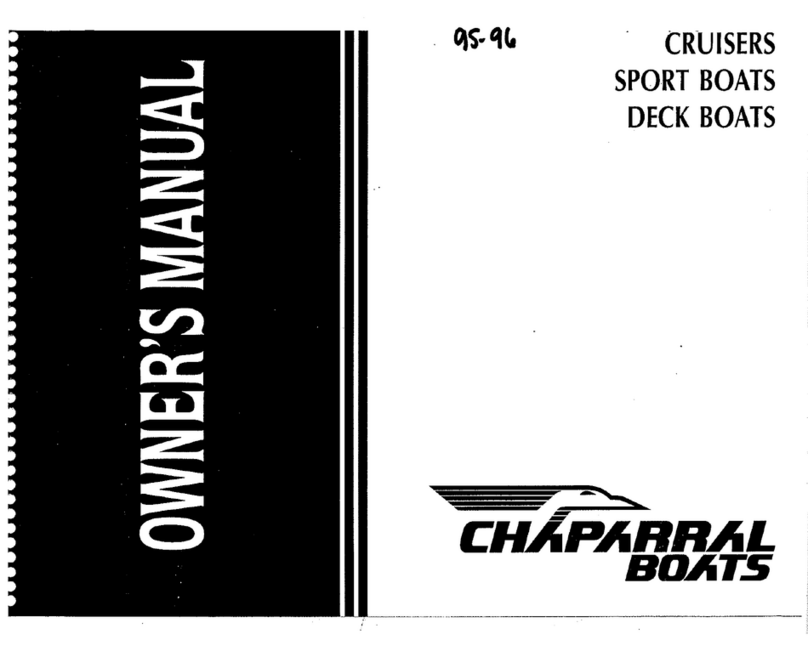
Chaparral
Chaparral Cruiser 1995 Series owner's manual
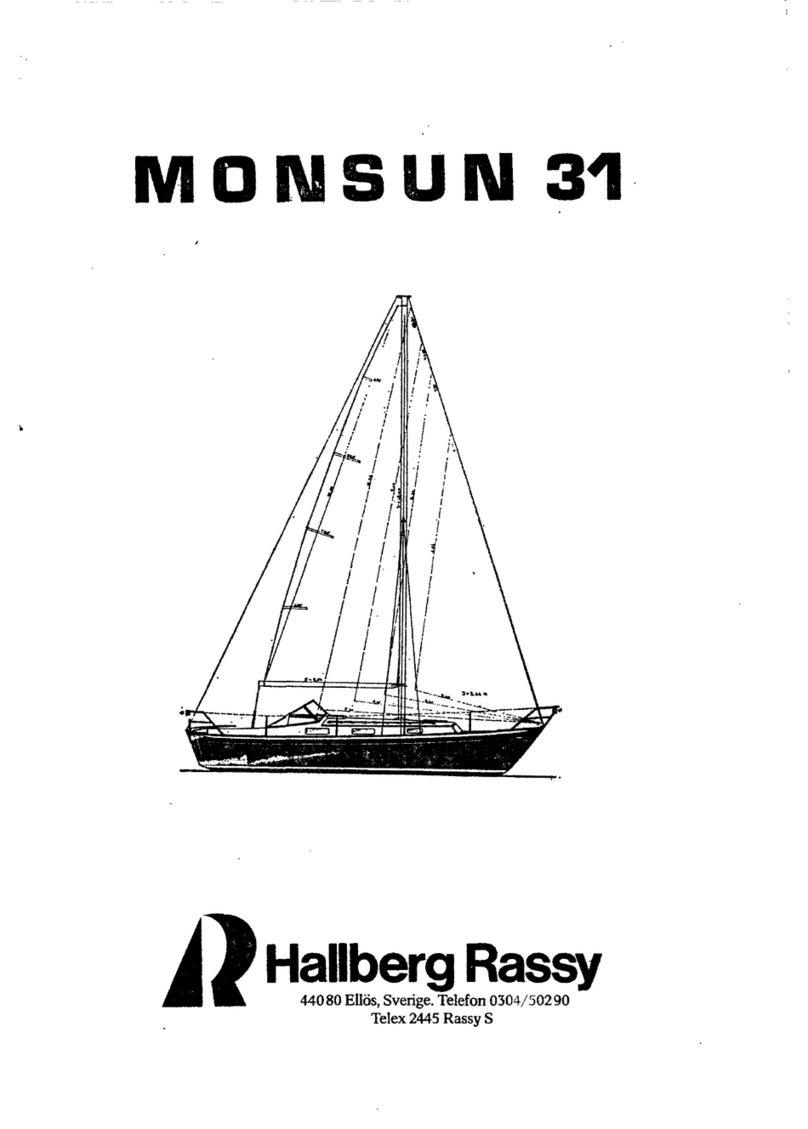
Hallberg-Rassy
Hallberg-Rassy MONSUN 31 instructions
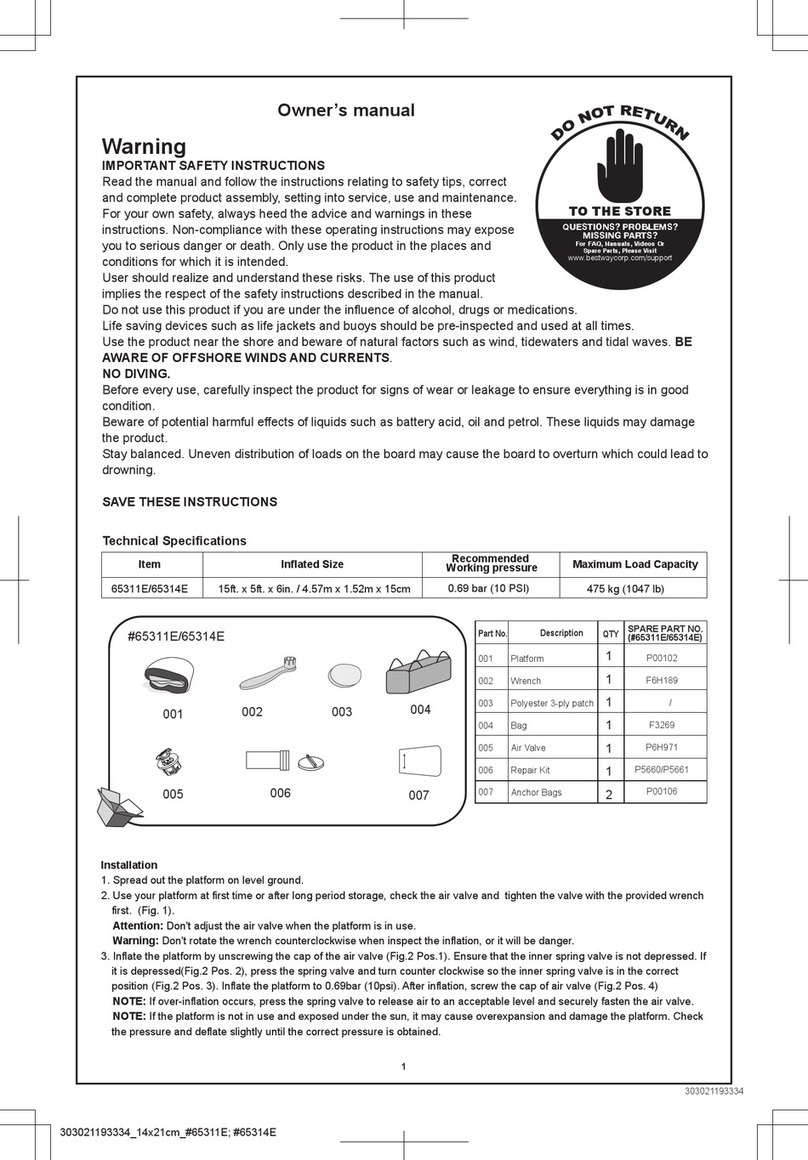
Bestway
Bestway 65311E owner's manual
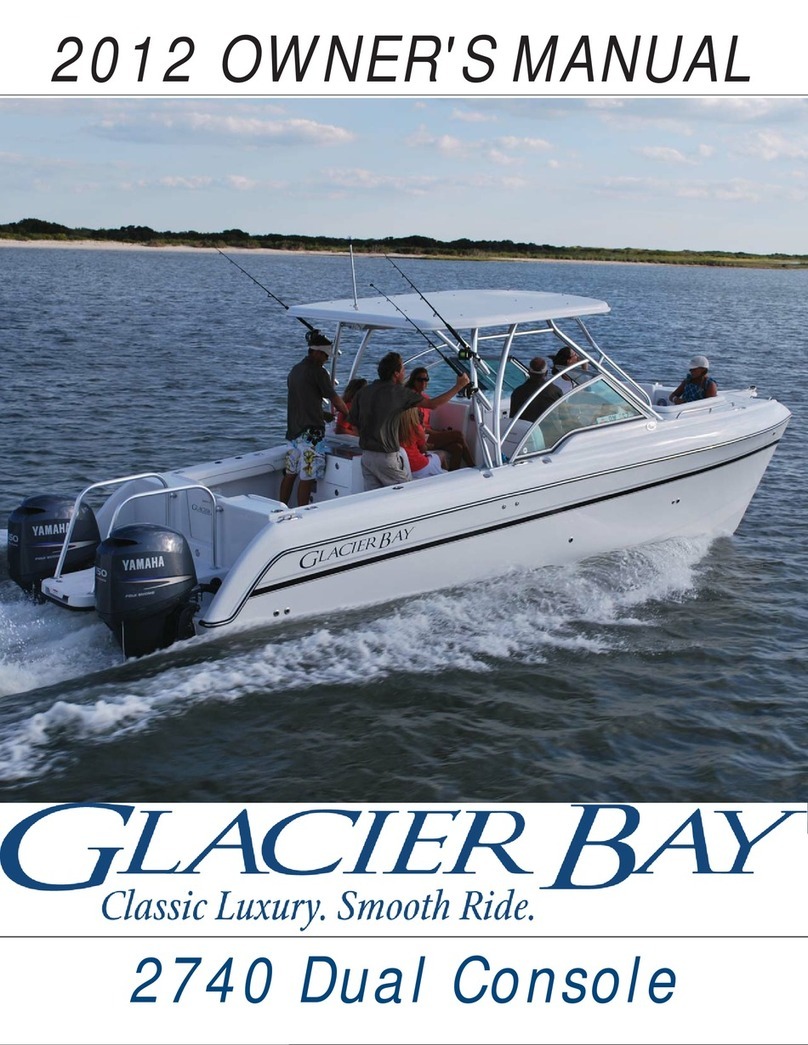
Glacier bay
Glacier bay 2012 2740 Dual Console owner's manual
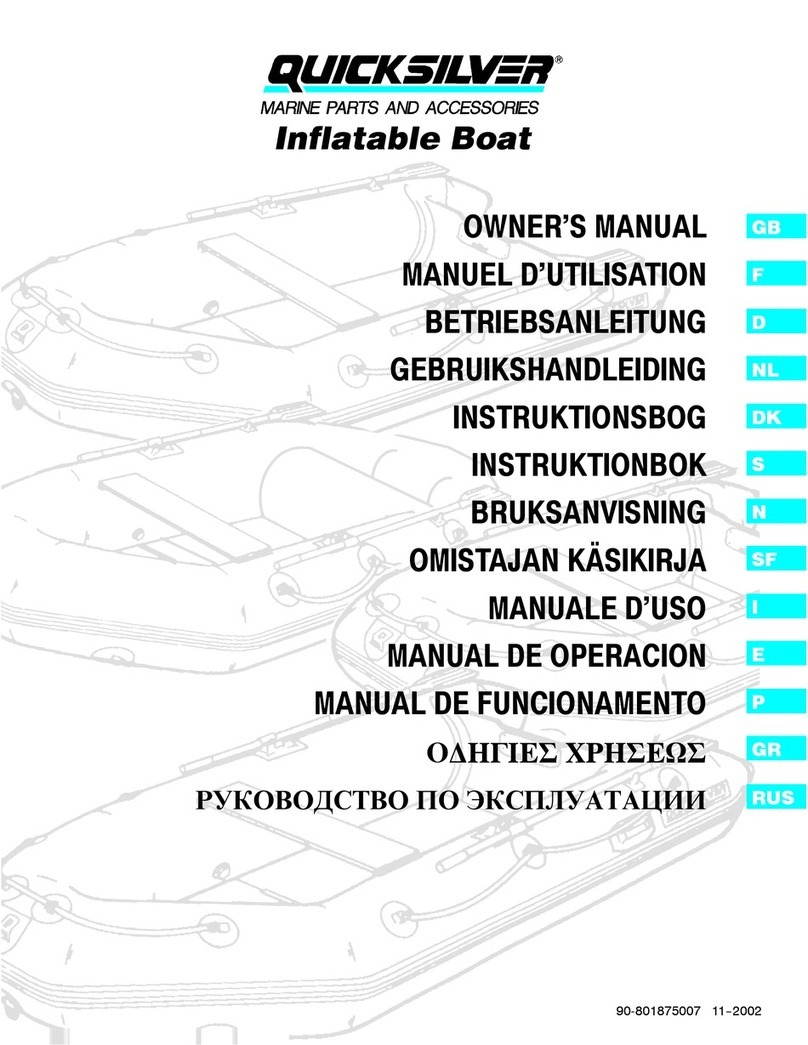
Quicksilver
Quicksilver AA430HD N owner's manual

Jeanneau
Jeanneau Sun Odyssey 490 Information & operation manual
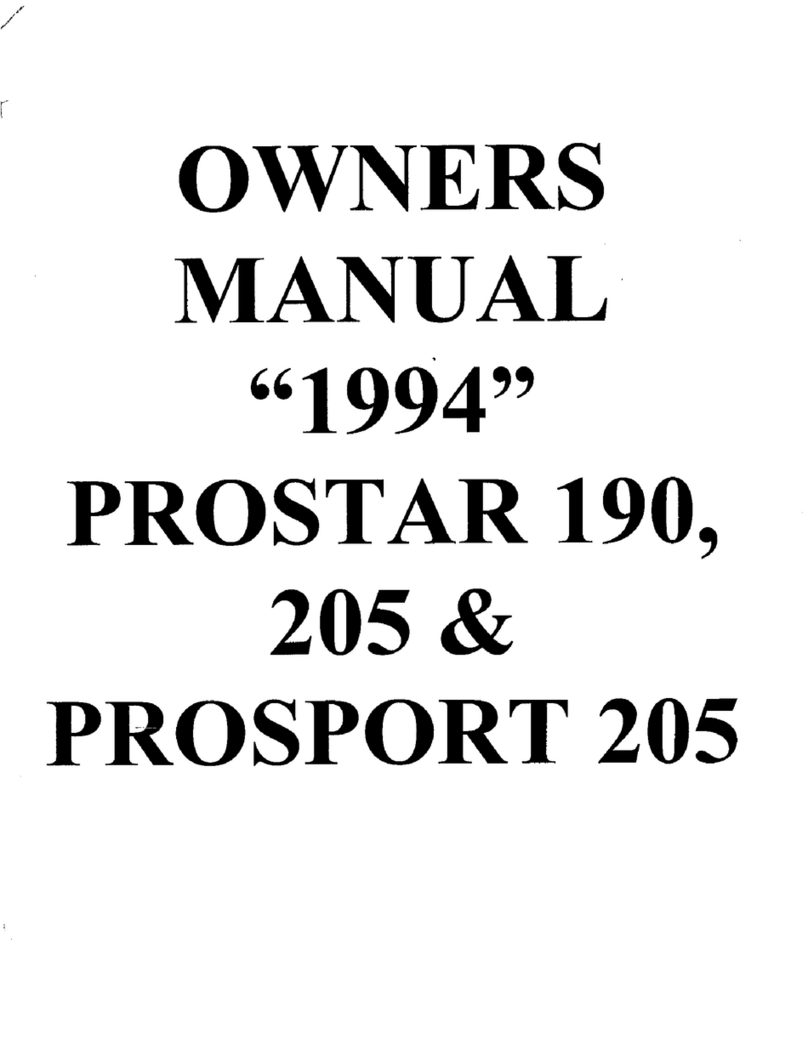
MasterCraft
MasterCraft ProStar 190 owner's manual
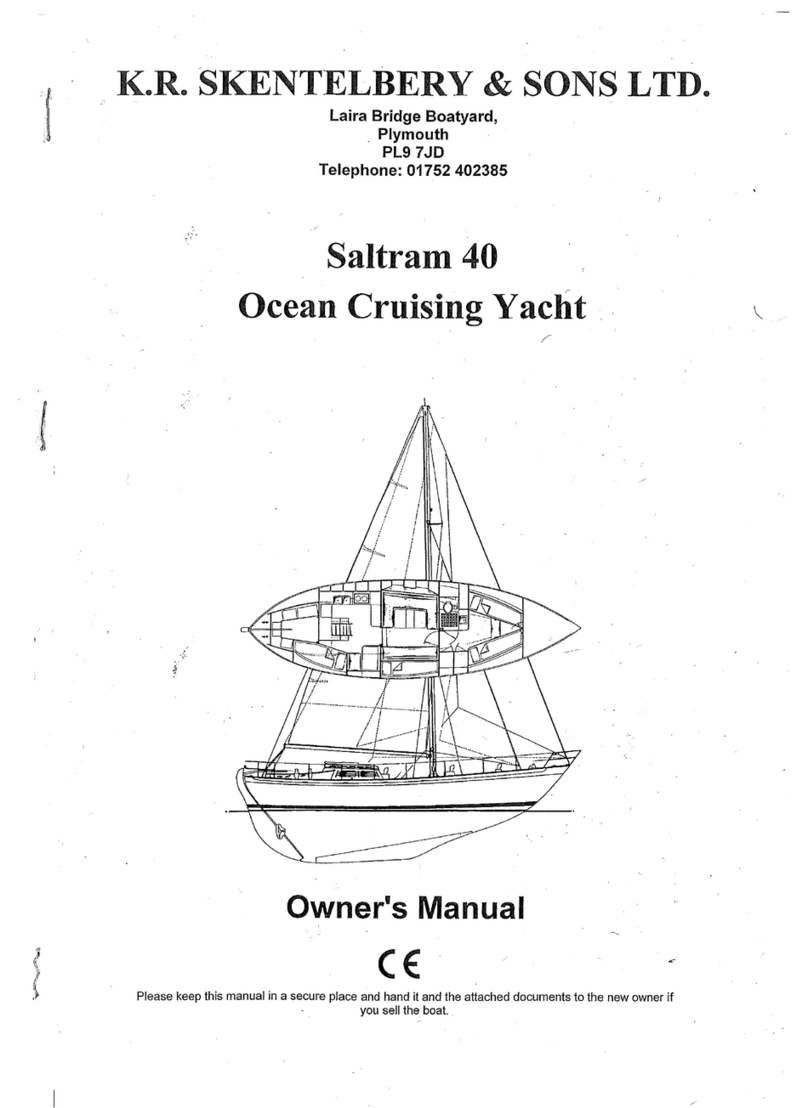
K.R. Skentelbery & Sons
K.R. Skentelbery & Sons Saltram 40 owner's manual

Quicksilver
Quicksilver 505 Cabin owner's manual
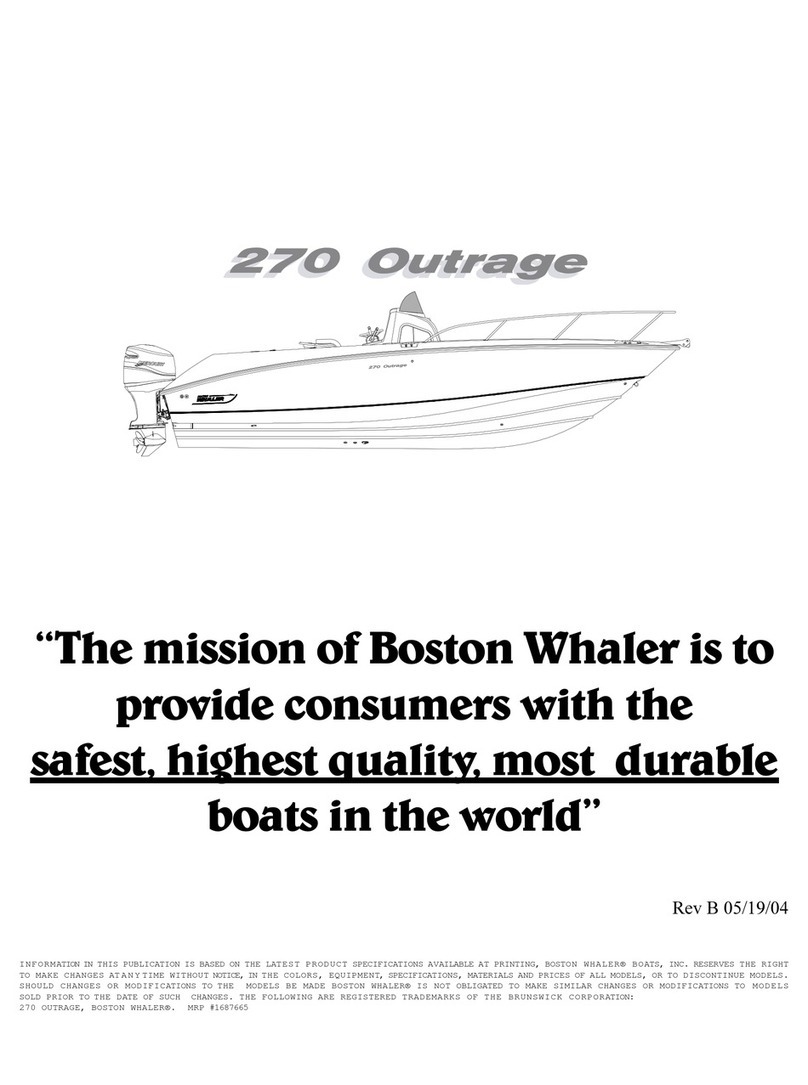
Boston Whaler
Boston Whaler 270 Outrage manual

Darfin Yachts
Darfin Yachts BENETEAU OCEANIS 400 manual

Zodiac
Zodiac PRO 500 owner's manual
